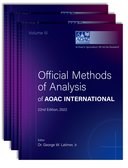 Official Methods of Analysis of AOAC INTERNATIONAL (22nd Edition)
Official Methods of Analysis of AOAC INTERNATIONAL (22nd Edition)
Contents
17.10.02
AOAC Official Method 992.18
Listeria species: Biochemical Identification Method
(MICRO-ID Listeria)
Get access
-
Published:January 2023
Cite
Listeria species: Biochemical Identification Method
(MICRO-ID Listeria)', in Dr. George W Latimer, Jr. (ed.), Official Methods of Analysis of AOAC INTERNATIONAL, 22nd Edition (
Extract
First Action 1992
Final Action 1996
(For presumptive generic identification of Listeria species isolated from foods and environmental test samples. Use of commercial biochemical kit as alternative to conventional biochemical testing is based on demonstration in analyst’s laboratory of adequate correlation between biochemical kit and conventional biochemical tests as described in current edition of Bacteriological Analytical Manual.)
See Table 992.18A for results of the interlaboratory study supporting acceptance of the method.
Principle
Method depends on principle that test inoculum contains preformed enzymes which can be detected after 24 h at 37°C. Test strip contains filter paper discs impregnated with chemical substrate/reagents specific for enzymes endogenous to Listeria spp. Substrates are converted to metabolic end products which react with detection system to produce visible color changes. Tests included in strip are listed in Table 992.18B. Each test is reported as either positive or negative. Typical results for each Listeria spp. are given in Table 992.18C.
Sign in
Personal account
- Sign in with email/username & password
- Get email alerts
- Save searches
- Purchase content
- Activate your purchase/trial code
- Add your ORCID iD
Purchase
Our books are available by subscription or purchase to libraries and institutions.
Purchasing information| Month: | Total Views: |
|---|---|
| July 2024 | 8 |
| September 2024 | 2 |
| October 2024 | 1 |
| November 2024 | 1 |
| December 2024 | 6 |
| February 2025 | 5 |
| March 2025 | 6 |
| April 2025 | 6 |




Get help with access
Institutional access
Access to content on Oxford Academic is often provided through institutional subscriptions and purchases. If you are a member of an institution with an active account, you may be able to access content in one of the following ways:
IP based access
Typically, access is provided across an institutional network to a range of IP addresses. This authentication occurs automatically, and it is not possible to sign out of an IP authenticated account.
Sign in through your institution
Choose this option to get remote access when outside your institution. Shibboleth/Open Athens technology is used to provide single sign-on between your institution’s website and Oxford Academic.
If your institution is not listed or you cannot sign in to your institution’s website, please contact your librarian or administrator.
Sign in with a library card
Enter your library card number to sign in. If you cannot sign in, please contact your librarian.
Society Members
Society member access to a journal is achieved in one of the following ways:
Sign in through society site
Many societies offer single sign-on between the society website and Oxford Academic. If you see ‘Sign in through society site’ in the sign in pane within a journal:
If you do not have a society account or have forgotten your username or password, please contact your society.
Sign in using a personal account
Some societies use Oxford Academic personal accounts to provide access to their members. See below.
Personal account
A personal account can be used to get email alerts, save searches, purchase content, and activate subscriptions.
Some societies use Oxford Academic personal accounts to provide access to their members.
Viewing your signed in accounts
Click the account icon in the top right to:
Signed in but can't access content
Oxford Academic is home to a wide variety of products. The institutional subscription may not cover the content that you are trying to access. If you believe you should have access to that content, please contact your librarian.
Institutional account management
For librarians and administrators, your personal account also provides access to institutional account management. Here you will find options to view and activate subscriptions, manage institutional settings and access options, access usage statistics, and more.